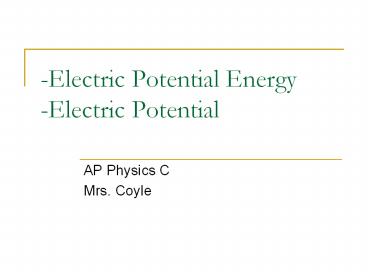-Electric Potential Energy -Electric Potential - PowerPoint PPT Presentation
Title:
-Electric Potential Energy -Electric Potential
Description:
-Electric Potential Energy -Electric Potential AP Physics C Mrs. Coyle Gravitational Potential Energy Higher Potential Energy Lower Potential Energy DUA-B= UB-UA ... – PowerPoint PPT presentation
Number of Views:270
Avg rating:3.0/5.0
Title: -Electric Potential Energy -Electric Potential
1
-Electric Potential Energy -Electric Potential
- AP Physics C
- Mrs. Coyle
2
Gravitational Potential Energy
A
Higher Potential Energy
DUA-gtB UB-UA - Wfield
Lower Potential Energy
B
3
Consider a positive test charge in the following
electric field.
A
Higher Potential Energy
DUA-gtB UB-UA - Wfield
Lower Potential Energy
B
4
Electric Potential Energy
- When a point charge qo is in an electric field E
- The force from the field is FqoE
- The work that the force of the electric field
does to move the charge from point A to B (in the
direction of the field) is WFd - As the charge is moved by the electric force it
loses potential energy but gains kinetic energy.
5
Change in Electric Potential Energy
- Change in Electric Potential Energy
- (Final PE- Initial PE)
- DUA-gtB UB-UA - Wfield
- The (-) sign (- Wfield ) indicates the loss of
potential energy when the charge moves in the
direction of the field.
6
The Electric Force is Conservative
- The force, F qoE, caused by the electric field
and experience by the charge is conservative.
That is - The work done by the conservative force does not
depend on the path taken. - A trip back to the original position would have a
change in energy of zero.
7
- Consider an infinitesimal displacement vector ,
ds, that is oriented tangent to a path through
space.
ds
8
- The work done by the electric field is
- W F.ds qoE.ds
- As this work is done by the field, the potential
energy of the charge-field system is changed by
?U -qoE.ds - For a finite displacement of the charge from A to
B,
9
- Change in potential energy of the system.
10
Electric Potential Energy
- Which point is at a higher electric potential
energy location? Consider a positive test charge.
11
If qo is negative, then ?U is positive when the
charge is moved in the direction of the electric
field by an external force.
- Consider the analogy of a bow and arrow. If you
pull back the arrow from the bow, the arrow will
gain potential energy. - In order for a negative charge to move in the
direction of the field, an external agent must do
positive work on the charge.
12
- Electric Potential Difference (Voltage )
- work per unit charge required to move a charge
- between two positions in an electric field.
- DV W/q , qo is a positive test charge
- Scalar
- Unit 1 Volt 1 J / C
- It takes one joule of work to move a 1-coulomb
charge through a potential difference of 1 volt
13
Electric Potential
- The potential energy per unit charge, U/qo, is
the electric potential - The potential is independent of the value of qo
- The potential has a value at every point in an
electric field - The electric potential is
14
Electric Potential
- The potential is a scalar quantity
- As a charged particle moves in an electric field,
it will experience a change in potential
15
Using Conservation of Energy
- Using conservation of energy, if the voltage
difference is known, the potential energy
difference can be calculated for a given charge. - If all the potential energy is converted to
kinetic energy, then final speed can be
calculated.
16
Electron-Volts
- A unit of energy
- One electron-volt is defined as the energy a
charge-field system gains or loses when a charge
of magnitude e (an electron or a proton) is moved
through a potential difference of 1 volt - 1 eV 1.60 x 10-19 J
- Remember that e1.60 x 10-19 C
17
Summary of Charged Particle Released from Rest in
a Uniform Field
- A positive charge released from rest moves in the
direction of the electric field. - The change in potential is negative.
- The change in potential energy is negative.
- The force and acceleration are in the direction
of the field.
18
Potential in a Uniform Electric Field
- ?V-Ed
- E -?V/dThe negative sign indicates that the
electric potential at point B is lower than at
point A - Another unit for electric field is 1 V/m 1 N/C
- We can interpret the electric field as the change
of the electric potential with position.
19
Electric Potential
- Which point is at a higher electric potential?
20
Note
- Electric Field lines point to the lower potential
21
Note
- Electric potential is independent of any test
charges that may be placed in the field. - Electric potential is a characteristic of the
field.
22
Equipotentials
- Point B is at a lower potential than point A
- Points B and C are at the same potential
- Equipotential surface is a surface consisting of
a continuous distribution of points having the
same electric potential
23
Equipotentials and Field Lines
- Equipotential surfaces are always perpendicular
to field lines.
24
Equipotential Lines
- Simulation of Field with Equipotential Lines
- http//glencoe.mcgraw-hill.com/sites/0078458137/st
udent_view0/chapter21/electric_fields_applet.html































